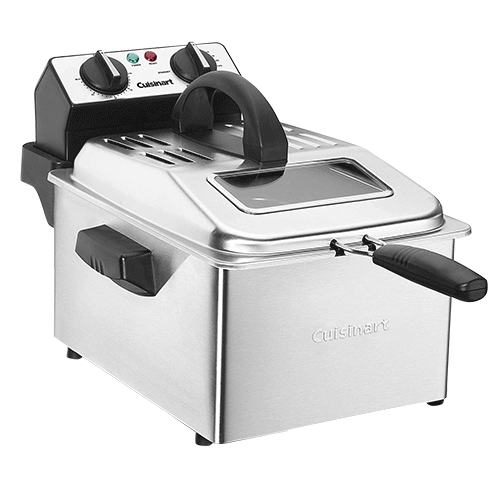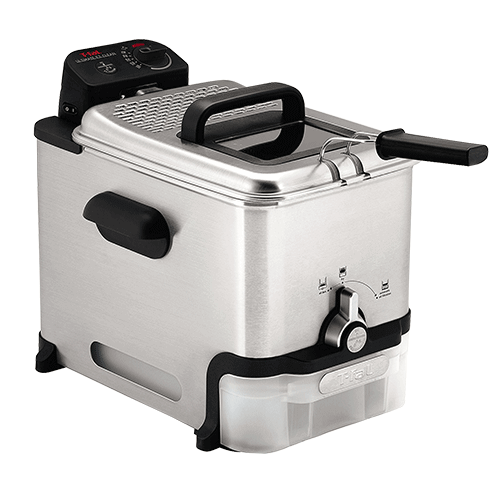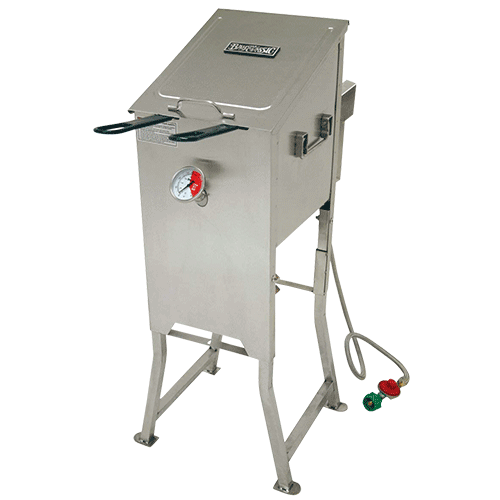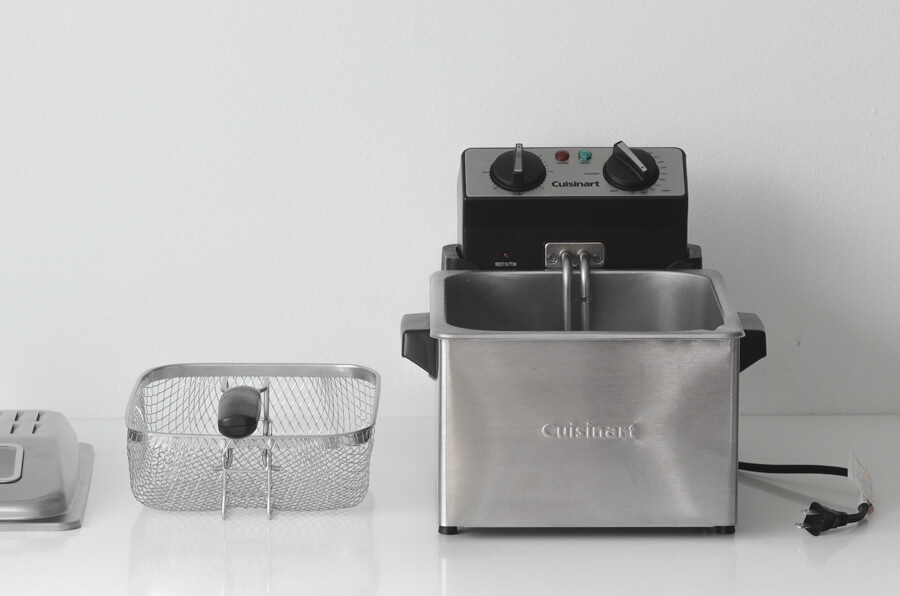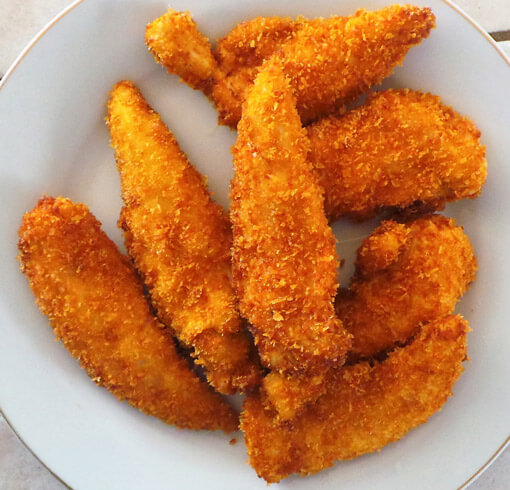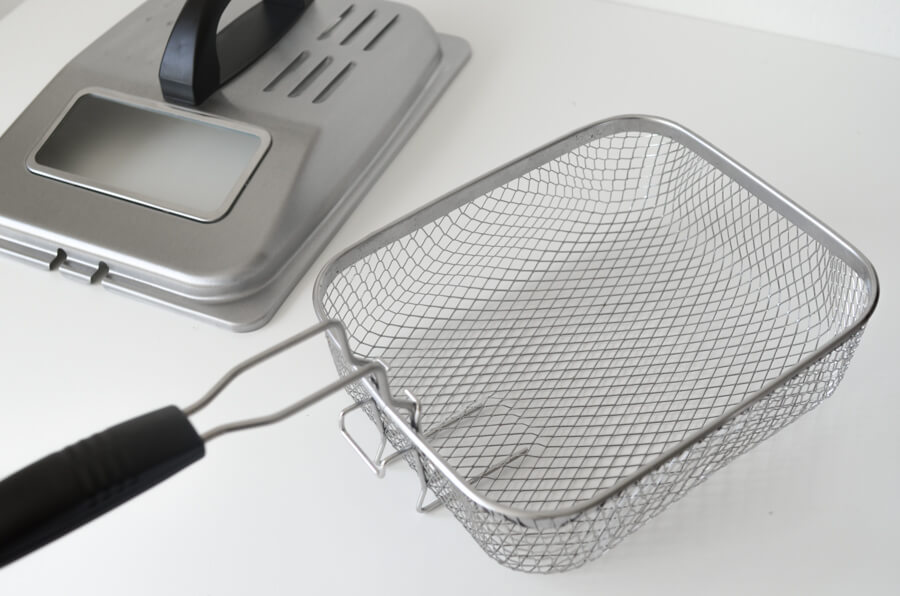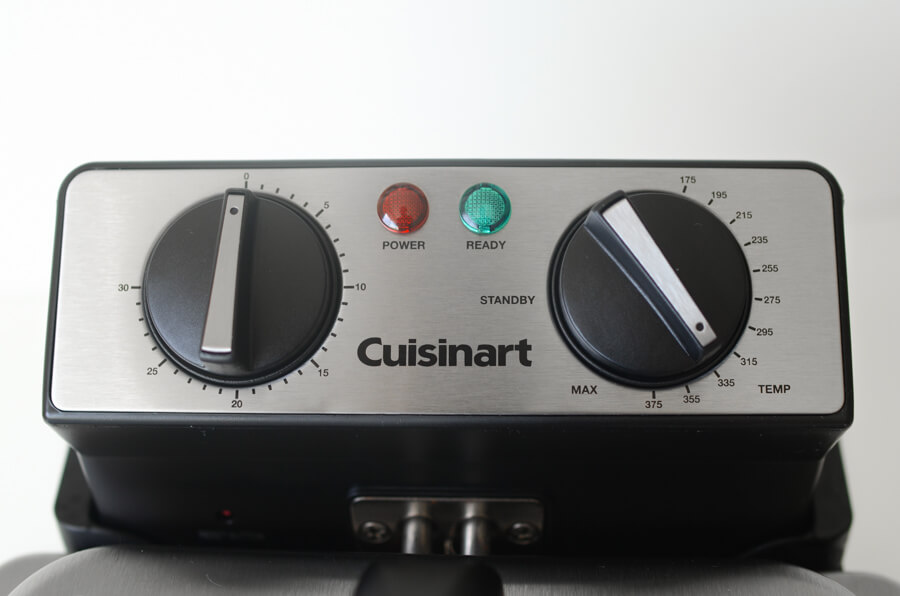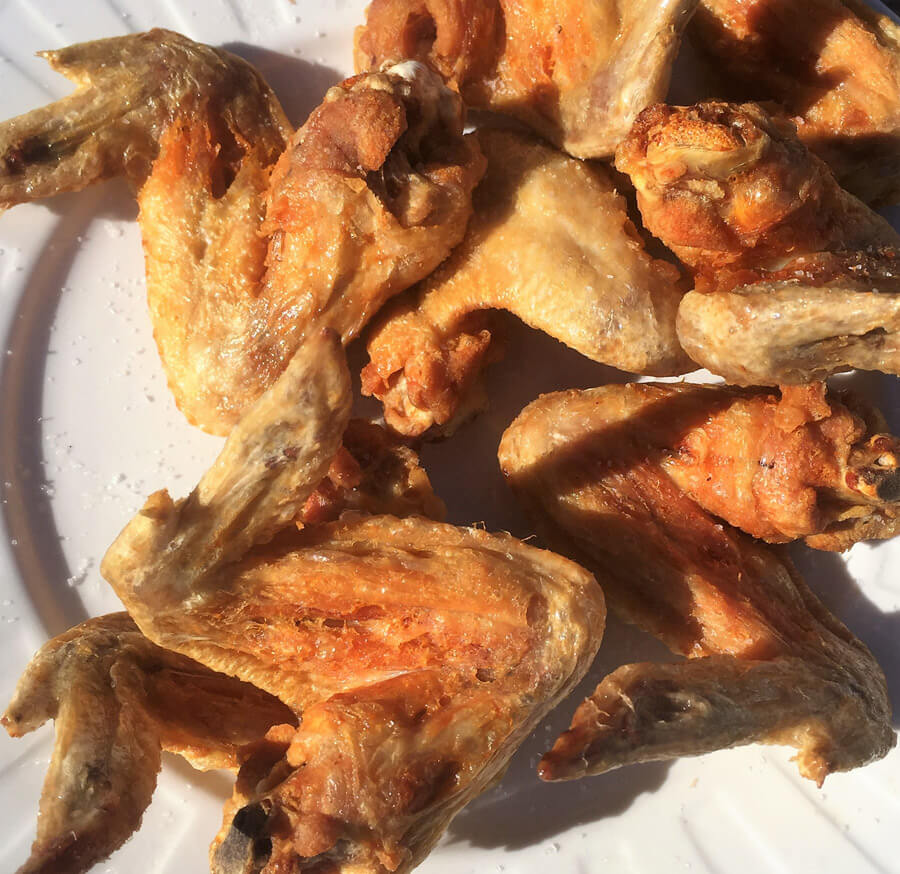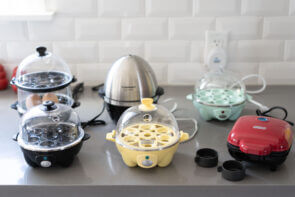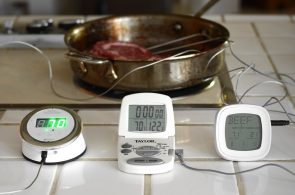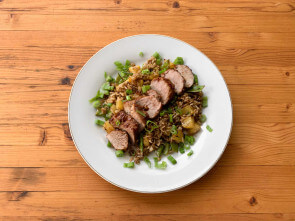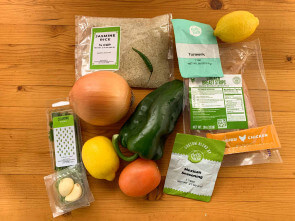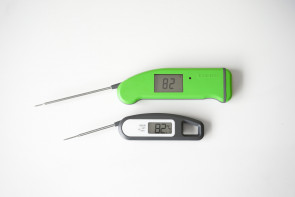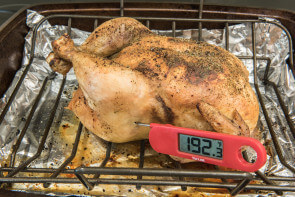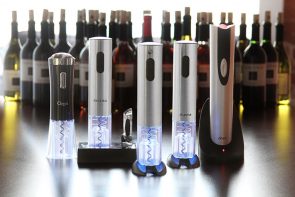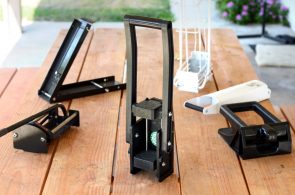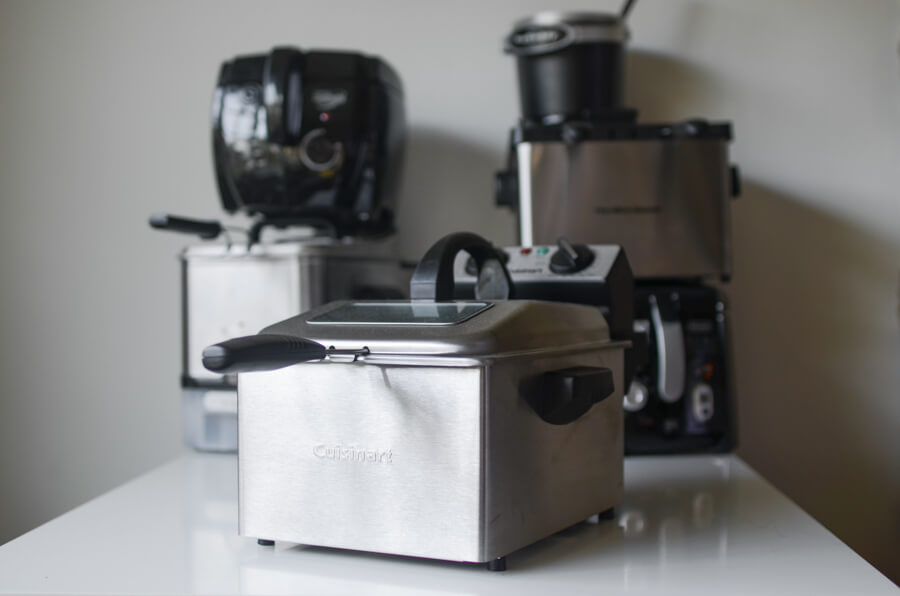
The Best Deep Fryers
For this article, we worked with a professional chef with 10 years of professional kitchen experience to find the best deep fryer. We put seven top products through a series of tests, frying over 30 pounds of chicken tenders, chicken wings, and French fries, to determine the Cuisinart – CDF-200 is the best home kitchen-sized deep fryer on the market. At a somewhat higher price, the T-Fal – FR8000 Ultimate EZ Clean is our runner-up pick and comes with a unique oil filtration feature.
For this article, we worked with a professional chef with 10 years of professional kitchen experience to find the best deep fryer. We put seven top products through a series of tests, frying over 30 pounds of chicken tenders, chicken wings, and French fries, to determine the Cuisinart – CDF-200 is the best home kitchen-sized deep fryer on the market. At a somewhat higher price, the T-Fal – FR8000 Ultimate EZ Clean is our runner-up pick and comes with a unique oil filtration feature.
Table of contents
- The 7 deep fryers we tested
- Best overall: Cuisinart CDF – 200
- Also great: T-Fal – FR8000
- Budget pick: Presto – Fry Daddy
- Best for serious enthusiasts: Bayou – Classic
- Other products we tested
- How we selected
- How we tested
- Important features to consider
- The bottom line
The 7 deep fryers we tested
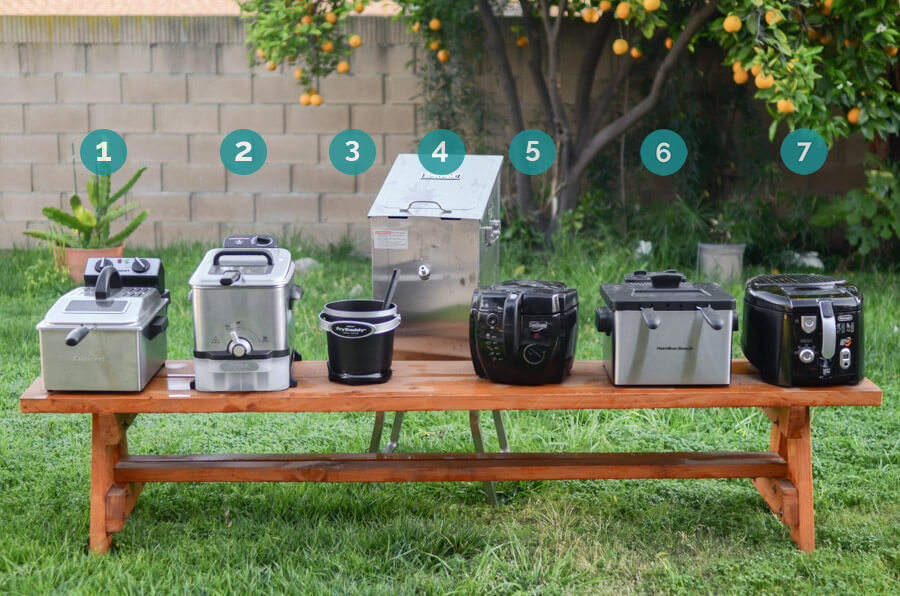
| Product | Price | Oil Capacity | Food Capacity | Actual Max. Temp. |
|---|---|---|---|---|
| 1. Cuisinart CDF-200 | $$ | 16 cups | 40 ounces | 348 °F |
| 2. T-Fal FR8000 Ultimate EZ Clean | $$$ | 14 cups | 35 ounces | 340 °F |
| 3. Presto 05420 Fry Daddy | $ | 4 cups | 32 ounces | 360 °F |
| 4. Bayou Classic 700-701 | $$$$ | 64 cups | 48 ounces | 375 °F |
| 5. Presto Cool Daddy Cool Touch | $ | 8 cups | 24 ounces | 350 °F |
| 6. Hamilton Beach 3-Liter (#35034) | $$ | 16 cups | 40 ounces | 355 °F |
| 7. DeLonghi Roto Deep Fryer | $$$ | 5 cups | 12.5 ounces | 345 °F |
Best overall: Cuisinart CDF – 200
The Cuisinart – CDF-200 is by far the best of the deep fryers we tested. It’s a well-constructed unit and was the only fryer that actually reached the optimal 375°F (in fact, it actually reached 383°F). Although its reheat time was slow, it did maintain a sufficient temperature to cook all the test foods evenly and without oily residue.
The Cuisinart has a sleek, brushed stainless steel casing and comes with a basket that easily held two-and-a-half pounds of chicken wings and two pounds of chicken tenders. The basket’s retractable handle makes it easy to store within the unit when not in use.
The fryer has a stand-alone, built-in timer that does not control the power of the fryer, and its thermostat is more accurate than most.
Its initial heat time to 360°F was relatively fast at 11-1/2 minutes, and heating to 375°F took less than two minutes. When food was lowered into the oil, the heat of the oil dropped, and although the oil reheated to only 348°F maximum, the temperature was high enough for excellent results.
Chicken and fries were all dark golden with crispy exteriors and soft or juicy interiors. Best of all, none of the food was greasy and was restaurant-quality.
On the negative side, the thermostat fluctuates a bit. For example, the thermostat didn’t register that the oil had reached 375°F until it was actually 383°F. On another test, we lowered the thermostat to 340°F, but it didn’t register that the oil had hit 340°F until it was actually 350°F. Since built-in fryer thermometers tended to be inaccurate, we recommend you periodically test the oil with a candy/deep-fryer thermometer or an instant-read thermometer.
As with all of the fryers we tested that had a viewing window, due to the splatter of oil and steam during the cooking process, the window is virtually useless. We found it much easier to gauge how the food was cooking by removing the lid after a couple of minutes when the food’s external moisture was mostly released.
Since all of the electric deep fryers had issues with maintaining the oil temperature, we tested whether keeping the lid on affected the temperature, and we found there was no difference with the lid on or off.
During our research, we spoke with Waring on the phone. They let us know that they’ve recently discontinued manufacturing home deep fryers and is transferring all models to Cuisinart. The Cuisinart CDF-200 was formerly manufactured by Waring (model DF250B) and Waring deep fryers are available for purchase at the time of this writing, but only while current stock lasts.
Key takeaways:
- The Cuisinart – CDF-200 is a sleek, attractive unit that is well-constructed and can be stored either in a cabinet or on the countertop.
- It has a large frying basket that can accommodate two and a half pounds of food.
- Its retractable basket handle makes storage easier.
- Its high wattage (1800 watts) helps heat and reheat oil quickly.
- Restaurant-quality results with food crispy and not greasy at all.
- Easy and convenient clean-up.
Also great: T-Fal – FR8000
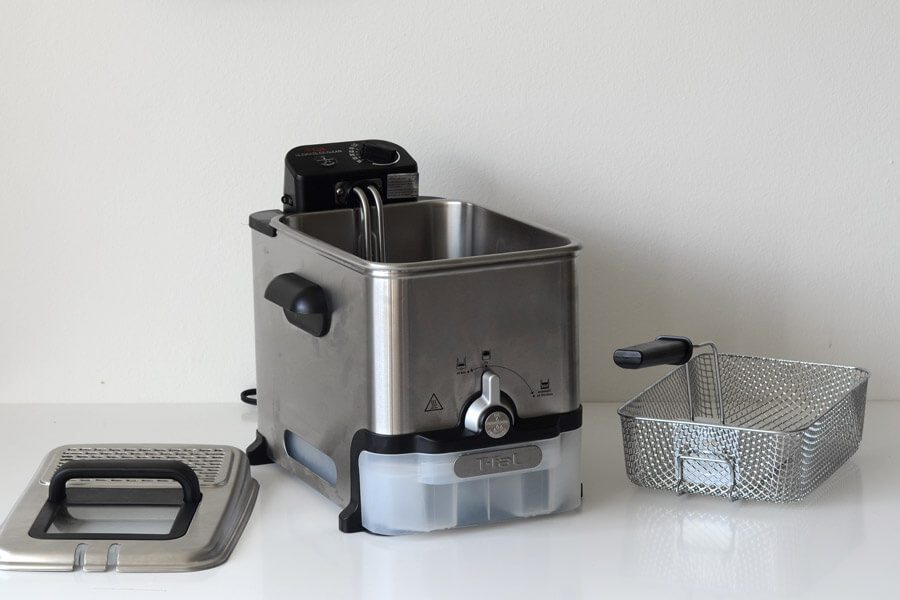
The T-Fal – FR8000 is one of the highest customer-rated electric deep fryers on Amazon. There is certainly a lot to love with this deep fryer. First of all, it is by far the easiest to clean of all the fryers we tested. The T-Fal deep fryer is unique for its ingenious, patented internal oil filtration and storage system, which truly does make cleaning up the “ultimate EZ clean”.
Once you’ve finished frying and allowed the oil to cool down (for approximately three hours), you turn a knob on the front of the fryer, which begins the filtration process. (If you wish to fry again later, simply leave the knob in the “frying” position.) The oil begins to drain through a small mesh basket into a plastic container beneath the oil box. This container can then be removed and refrigerated for future use. Some online reviews cite leakage from the corners of the plastic storage box, but we did not have this issue.
There is some confusion in the instruction manual about when you may begin the filtration process after frying. We called T-Fal and confirmed that the oil should indeed be cooled before switching the knob to the drain position.
One of the small but appreciated touches of the fryer’s design is the unique rubber grips in the slots for the handle. Once you’ve lowered the food into the oil, the handle slips firmly into place, unlike all the other fryers in which the handle is not secure.
The entire deep fryer is designed to make clean up extremely easy. Everything — excluding the heating coil — is dishwasher safe. All the food that we cooked in the T-Fal was visually and texturally appealing. It was also somewhat greasy, but not a huge deal. Its inability to reheat the oil to the optimal frying temperature once food was added contributed to our rating the T-Fal as the runner-up, but overall it is still a great pick.
Key takeaways:
- The T-Fal – FR8000’s patented automatic oil filtration system and storage system make clean-up easy and convenient.
- Excellent filter removes food particles so oil may be reused many times.
- Aside from the heating coil, the entire unit is dishwasher safe.
- Its basket handle and grips are well designed to securely hold the basket in place.
Budget pick: Presto – Fry Daddy
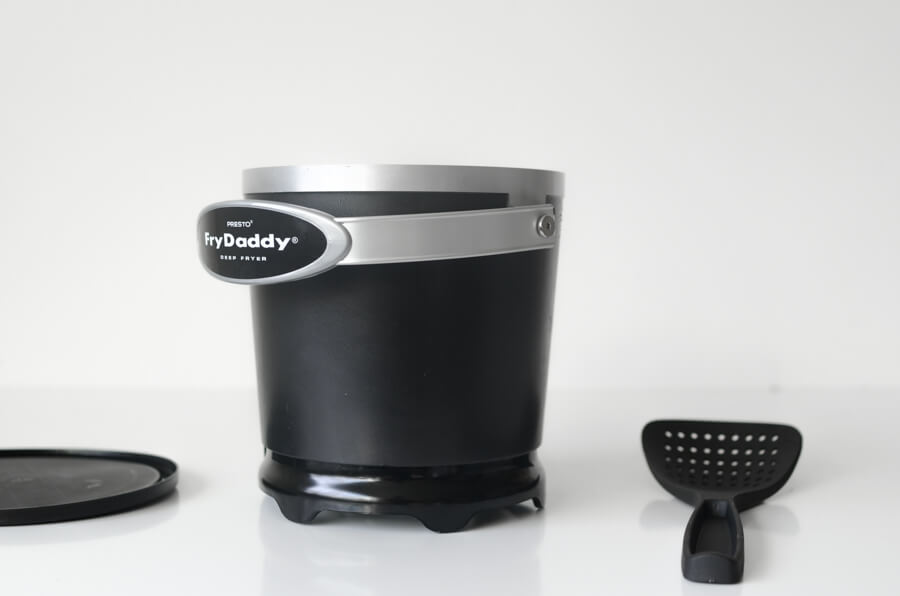
The Presto – Fry Daddy is a small four-cup capacity fryer that is really nothing more complicated than a heating pot. Its compact size makes Fry Daddy convenient to store and easy to clean. It’s not dishwasher-safe, but a warm soapy cloth does the trick.
During our tests, the oil reached a maximum temperature of 360°F, which was just hot enough to fry the chicken and fries nicely. All of the food fried with the Fry Daddy was crispy with no oily after-taste.
The Fry Daddy has no added features like other more expensive deep fryers, but it does come with a nifty silicone strainer to remove food from the hot oil. A lid for covering and storing the entire unit is also included. It’s recommended that the oil be cooled and strained before storage in the refrigerator.
The Fry Daddy sells for a terrific budget price of under $17 from Amazon (the time of publishing), and for couples or a family of four, this nice little R2D2 of deep fryers is a great choice.
Key takeaways:
- The Presto – Fry Daddy uses only four cups of oil.
- Heats and maintains oil at a consistent temperature of 360°F.
- Its nice, compact size allows convenient storage and is very easy to clean.
- Filtered oil can be stored and refrigerated in the unit itself.
Best for serious enthusiasts: Bayou – Classic
The Bayou – Classic is one of the highest-rated fryers on Amazon and with good reason. It stands apart from the other fryers we tested, primarily because it is much larger and it’s propane-fueled. The propane allows you to control the oil’s temperature better and maintain the high temperatures needed for perfectly fried food.
However, since it is propane-fueled, the Bayou Classic is an outdoors-only fryer and must be constantly monitored while the oil is heating and during the frying. This isn’t a set-it-and-forget-it type of fryer, but if you’re a serious enthusiast who needs to fry large volumes of food, the Bayou Classic is definitely the one you should consider purchasing.
The Bayou Classic is well-constructed from stainless steel, and although it took us about an hour to put the fryer together, it wasn’t difficult. In fact, the instruction manual is one of the most detailed we’ve seen, but it’s also packed with warnings about temperature control and required tests for the propane connector and jet burner.
The Bayou – Classic comes in three sizes: two and a half gallons, four gallons, and nine gallons. We tested the 4-gallon, Model #700-701. Once everything was hooked up, we poured in the oil and turned on the propane at a medium level. The oil heated up to 340°F in 22 minutes. This may seem like a long time, but the manual is very specific about heating the oil slowly.
An internal thermometer, which needs to be installed, works reasonably well, although we did find it had a variance of five-to-ten degrees from the temperatures we continually took with the candy/deep-fryer thermometer and the instant-read thermometer.
For all of the food tests, the oil temperature dropped at most 15 degrees, but it rapidly regained heat in a little over four minutes, which is much faster than any of the electric fryers we tested. The gas regulator enables you to control the oil temperature, and the thermometer has a warning to turn off the gas when it hits 400°F, which is, in fact, too high for deep frying.
Thanks to the Bayou Classic’s ability to maintain 375°F, the all fries and chicken wings cooked perfectly: golden, crunchy, and not the slightest bit oily. The only test that was less successful was the chicken tenders. Although they cooked in a remarkable one minute and 18 seconds, the interiors were slightly underdone.
The Bayou Classic comes equipped with a rather cumbersome drain hose for draining and recycling the oil, which still needs to be filtered and funneled into a suitable storage container. Also, the Bayou Classic is somewhat difficult to clean due to its size. These are minor quibbles on a generally superior product. The Bayou Classic is a great choice for someone who needs to fry large quantities of food and has the extra yard space to store this unit.
Key takeaways:
- The Bayou – Classic has a sturdy stainless steel construction, which retains the propane-fueled heat and maintains oil temperature.
- Considering its four-gallon capacity, the fryer heats up to optimal frying temperatures in a relatively quick time.
- Excellent for frying large quantities and different types of food at the same time.
- Restaurant-quality baskets and a reasonably accurate internal thermometer are included.
- Good price for the overall quality of the fryer
Other products we tested
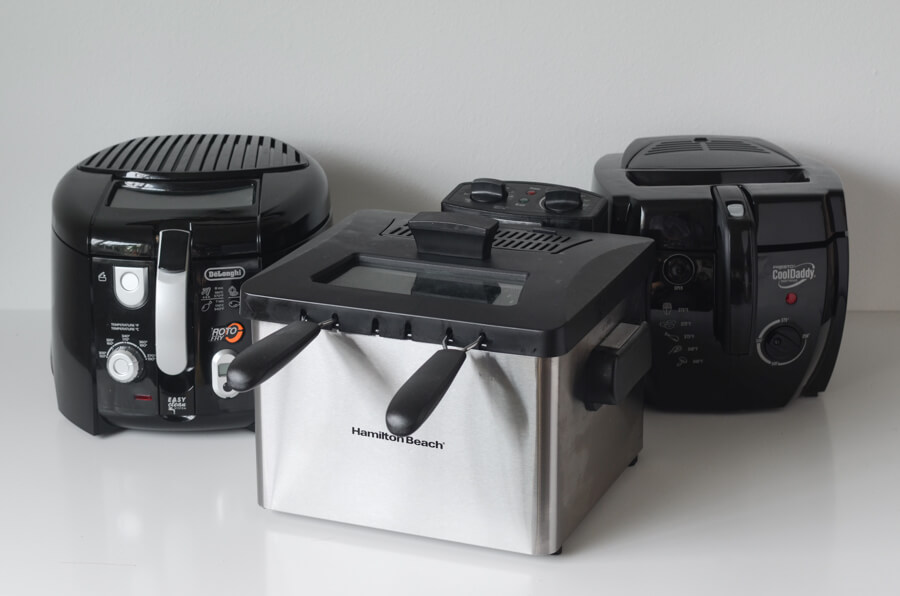
DeLonghi Roto Deep Fryer
The DeLonghi Roto Deep Fryer is an interesting concept. The fryer only requires five cups of oil, and the basket, once inserted, tilts downward and revolves, presumably so that the food fries evenly. Unfortunately, despite its stylish design (it was the most aesthetically pleasing of all the fryers), we needed to constantly turn the food to ensure uniform cooking. Even with 1500 watts, the unit simply did not get hot enough, which resulted in soggy and oil-laden chicken and fries.
In keeping with its thoughtful physical design, the DeLonghi is equipped with a built-in oil drainage pipe. It doesn’t have an internal filtration device, but the pipe allows you to easily drain the cooled oil through a lined filter into a storage container.
Hamilton Beach Electric Deep Fryer
The Hamilton Beach Electric Deep Fryer (35034) comes with three baskets; one large and two small, which enables you to fry two types of food simultaneously, for example, fries and onion rings. However, the food capacity in the small baskets does not come close to suggestions in the instruction manual. We fried one pound of fresh and frozen fries, dividing them into equal portions into the small baskets. The manual suggests 18 ounces per basket; however, the Hamilton Beach struggled to cook eight ounces in each basket and the fries emerged crispy but oily.
The fryer’s construction also appears rather shoddy. The thin aluminum casing buckles easily when the enameled oil pot is inserted into it. The thermostat fluctuates continually, registering 375°F when in actuality the oil has only reached 355°F (in 19 minutes). We can conjecture that the reason this fryer is unable to heat up and maintain optimal heat is because of its flimsy outer casing.
Lastly, the lid captures so much steam during the frying process that it’s a bit dangerous to lift the lid off since the steam drips into the oil and causes spattering.
Presto Cool Daddy
The Presto Cool Daddy Cool Touch Deep Fryer has a nice ergonomic design. It’s compact and easy to clean, although it is not dishwasher safe. The fryer is also not actually “cool touch”; it heats up quite a lot, but you could still touch it – to move it, for example – without burning yourself.
Despite this cool-touch feature, results were mixed. To begin, the oil never reached the optimal temperature and hovered between 310°F and 340°F. Heating and reheating times were 15 to 20 minutes longer than other competitors.
Chicken and fries were pale to golden brown with crispy exteriors, but because of the unit’s inability to reheat to the optimal temperature, all of the food was greasy.
How we selected
As home cooks, we have some general options about electric deep fryers we can use. We wanted to focus on countertop models, meant to be used inside your kitchen. There are many larger, gas-powered deep fryers available that are meant to be used only outside. We only tested one just to give some context, but it was not the focus of our test.
Even when sticking to indoor kitchen counter-sized models, the machine size and oil capacities varied a lot. We found fryers that ranged between four and 16 cups of oil capacity so we wanted to test the whole range of that.
Most recipes call for deep frying around 350-375°F. You could always check the temperature of the oil as we did by using our top pick infrared thermometer or the best instant-read thermometer. There are, however, deep fryers that have adjustable temperature settings and a built-in thermostat.
Since there aren’t many other folks who have put multiple deep fryers to the test, we relied heavily on Amazon reviews to determine which to test. We scoured hundreds of individual reviews to discover what features were important to home cooks, and what made good or bad units.
Many brands produced multiple deep fryer models, so we avoided doubling up unless it had some unique features warranting testing (like the two Presto units we tested). Luckily, there were many models to choose from and we avoided anything with an average rating less than four stars, or units with an abnormally high proportion of one and two-star reviews.
If you’re health-conscious and want an alternative to frying your food in quarts of oil, you might consider looking into an air fryer. Although you’re sacrificing a bit of the taste and crunchy texture that deep fryers produce, an air fryer gives almost the same results but with nearly no fat absorbed by the food. If you’re interested in exploring air fryers, take a look at our review of the best air fryer.
How we tested
Oil-to-food ratio
Since the deep fryers we tested had varying capacities for oil and food, before testing we needed to calculate a ratio of how much oil to food would be equitable across the board for all of the fryers. For example, the Fry Daddy has only a four-cup maximum oil capacity, while the Hamilton Beach Deep Fryer and Cuisinart CDF-200 both have a 16-cup maximum oil capacity.
Our test food was frozen French fries, fresh French fries, raw chicken wings, and battered chicken tenders. Although the Fry Daddy manual claims to have a four-cup maximum food capacity, the amount of food that actually fit into its oil pot and could be submerged in oil was substantially less: Four ounces of frozen or fresh French fries, 10 ounces of raw chicken wings and eight ounces of chicken tenders.
The Cuisinart has a maximum oil capacity of 16 cups, so using the Fry Daddy’s food-to-oil ratio as the base, we calculated 16 ounces of French fries (a one-to-one food-to-oil ratio), 40 ounces of chicken wings (five-to-two food-to-oil ratio), and 32 ounces of chicken tenders (two-to-one food-to-oil ratio).
In another example, for the DeLonghi Roto Deep Fryer, which has a five cup maximum oil capacity, we tested five cups of French fries (1:1), 12-1/2 ounces of chicken wings (5:2), 10 ounces of chicken tenders (2:1).
Heating and temperature maintenance

The first test was the amount of time it took for the oil to initially heat to 360°F and then how long the unit heated the oil to the optimal temperature of 375°F.
Since heat recovery after food is added is a key element to deep frying, we then tested how long it took the oil to reheat to 360°F and 375°F after each of our test food was added.
The deep fryers that reached the initial heating temperatures of 360°F and 375°F were the Cuisinart CDF-200, Presto Fry Daddy, and the propane-fueled Bayou Classic. Only the Cuisinart and the Bayou Classic were able to reheat the oil to 375°F after food was added.
How the food was prepared and cooked

We used the exact same food products for all of the fryers:
- Ore-Ida frozen French fries
- Thinly cut russet potatoes (for fresh fries)
- Raw chicken wings
- Raw chicken tenders
The chicken tenders were dredged in flour, then dipped in an egg-milk wash, and finished with Panko bread crumbs. The frozen French fries, raw chicken wings, and battered chicken tenders were lowered into the heated oil per each fryer’s instruction manual.
We began timing the instant the food was submerged in oil. In most cases, cooking times were either considerably longer or shorter than the times recommended in the instruction manuals.

For the fresh French fries, we used the double-fry method. The raw fries were initially partially cooked in oil at 340°F. The fries were then drained and allowed to rest for at least 20 minutes. We then adjusted the thermostat so the oil would heat to 375°F and fried the partially cooked fries a second time until crisp and golden brown.
All of the cooked food was drained, seasoned lightly with sea salt, and tasted, and results were based on color, external (crispy), and internal (juicy or soft) texture, greasiness, and flavor.
Other test factors
Basket and handle: How easy was it to insert into the oil pot? This proved to be an important test. Several fryers’ instruction manuals advised placing the food into the basket and then lowering it into the oil. With the Hamilton Beach Electric Deep Fryer, proper insertion of the baskets and their handles was awkward, and the baskets fell into the oil causing a dangerous splatter.
Thermostat: How accurate was it? Every fryer (excluding the Fry Daddy, which does not have a thermostat) failed this test. Throughout the testing, we continually checked oil temperature with both a candy/deep-fryer thermometer and an instant-read thermometer, and none of the thermostats accurately set and maintained the temperatures required for deep frying.
Wattage: Was it powerful enough to heat the oil? Wattage ranged from 1200 watts (Fry Daddy) to 1800 watts (Cuisinart and Hamilton Beach). The Fry Daddy’s lower wattage worked well for its compact size. The Cuisinart and Hamilton Beach are approximately the same size, and although the Cuisinart performed best, the Hamilton Beach’s rather shoddy construction could be the reason why it struggled to reach and maintain a temperature higher than 355°F.
Convenience: Was the fryer easy to use and clean? All of the fryers were quite easy to put together and use right out of the box. Cleaning up, however, was a different issue. Except for the Fry Daddy, all of the fryers had some parts that were dishwasher safe and other parts that could only be cleaned manually.
Important features to consider
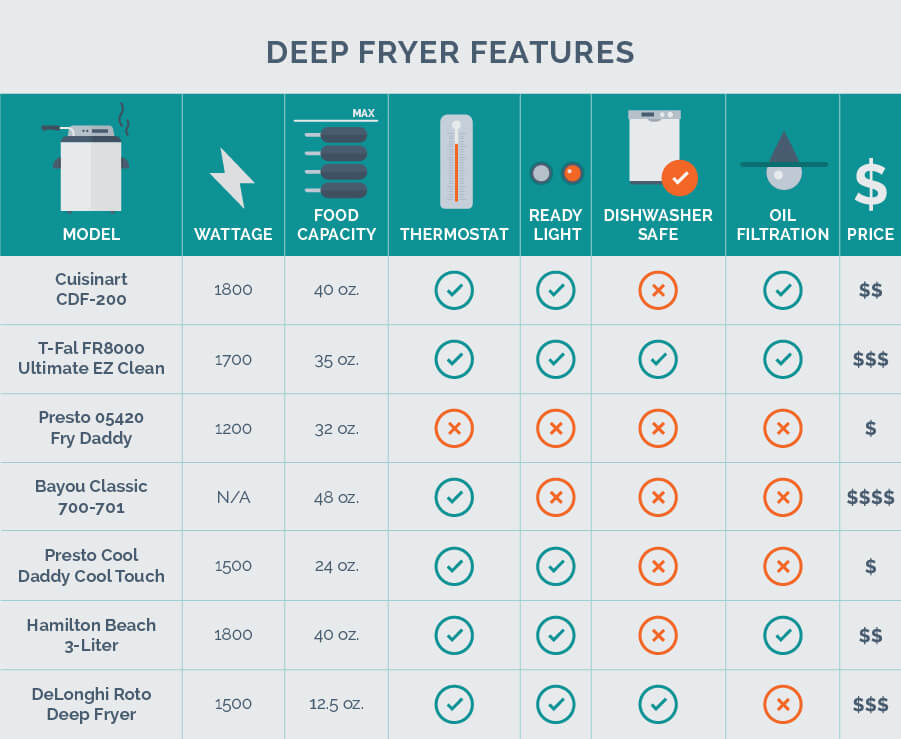
Before we began testing home fryers, we wanted to research the fryers that had specific, easy-to-use features.
Thermostat: Since it can be unsafe to continually test the temperature of the oil while it’s heating or cooking, we liked fryers that had reliable and accurate thermostats.
Oil drainage: Many fryers are designed to hold up to 16 cups of oil (excluding the propane-fueled Bayou Classic Fryer, which holds a whopping four gallons of oil), so we preferred fryers with oil filtration and drainage.
Basket size: Depending on how many people you’re cooking for, you’ll want a fryer that can hold a sizable portion of food so you don’t have to keep frying in batches.
Odor filter: Frying is notorious for leaving that fast-food smell in the house, so fryers with sufficient venting and odor filtration were a plus.
Safety: All of the fryers we tested had magnetic breakaway plugs, but some were sturdier than others. The plug is designed to quickly shut off the unit in case of a flare-up.
Splatter guard: All of the fryers we tested, except for one (the Presto Fry Daddy), had sufficient protection from oil splattering when food is added.
Ease of cleaning: There are two components: 1) is the fryer dishwasher safe? and 2) can the oil be stored in the fryer so manual filtration into a suitable container isn’t necessary?
Design: Could the fryer be stored in a cabinet or pantry or is it too large and must “live” on a countertop? Because of its size, would you use the fryer occasionally or frequently?
The best oil for deep frying
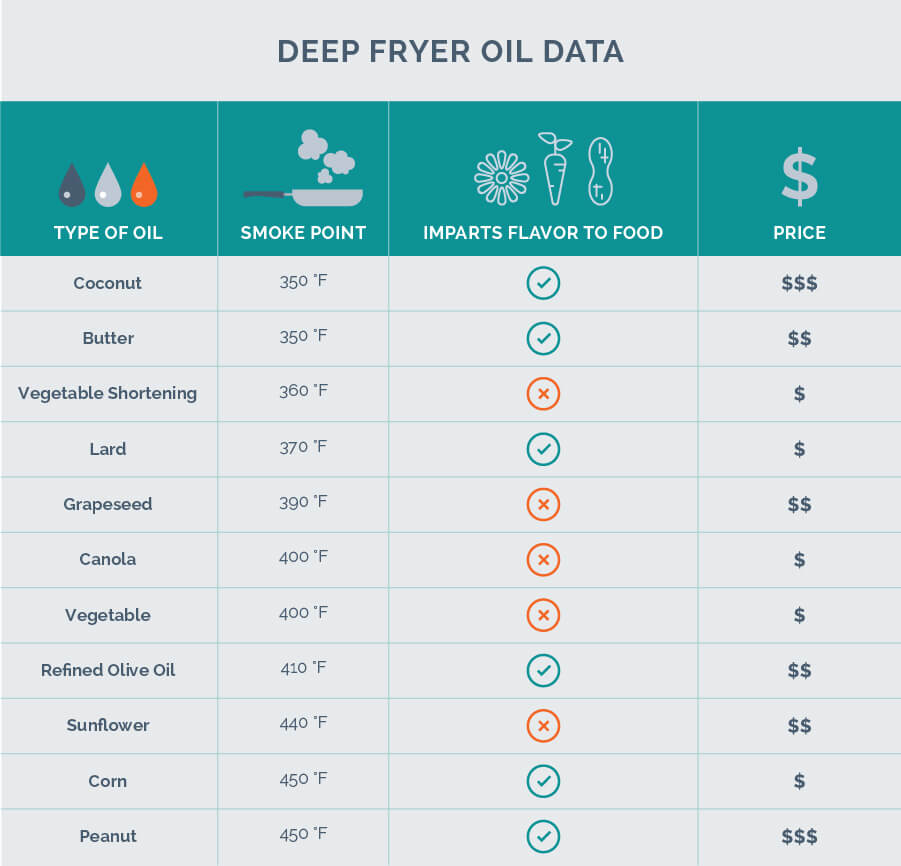
The type of oil used for frying is another key element to achieving perfect and crispy fried foods. Many restaurants use canola or vegetable oil and don’t change the oil frequently, which results in strong odors and lingering tastes of food previously fried in the oil. After a heavy volume of frying–especially if food particles aren’t strained–the oil degrades, foams, and turns rancid.
Different oils have varying smoke points–the temperature at which the oil begins to smoke and burn. For example, butter has a low smoke point (350°F); the fats in butter cook off rapidly and easily burn, as anyone who’s left a saute pan on the stovetop a little too long knows. Clarified butter or ghee, is an exception. The clarification removes the butter’s fats, resulting in a pure fat with a high smoke point of 450°F.
For frying, you will also want to choose an oil that is neutral tasting so it doesn’t affect the natural flavors of the foods you’re frying.
Olive oil (not extra virgin) is fine for deep-frying thanks to its relatively high smoke point of 420°F, but it does impart its taste into food.
Both canola and vegetable oil have a high smoke point of 400°F and are good for small batches of frying. However, they are lower-quality oils and can turn rancid sooner than other oils.
Peanut oil is generally praised as the best oil for deep frying with its smoke point of 450°F, and in our preliminary test runs of the fryers, we agree that peanut oil is excellent. It also imparts flavor into food, most noticeably French fries, which many people like.
The alternative we settled on was grapeseed oil. It has a smoke point of 390°F (none of the fryers we were testing heated above 375°F) and is completely neutral in taste. Grapeseed oil is also not as costly as peanut oil and can be purchased in two-liter (a little more than eight cups) jugs.
The best temperature for deep frying
Keeping the oil at the proper temperature is a crucial element to deep frying. As noted earlier, a consistent higher temperature results in the rapid dehydration of the food, thus creating a crispy exterior, soft and juicy interior, and minimal absorption of oil. For most recipes, it’s best to fry foods at an oil temperature ranging between 350°F to 375°F.
Just as important is how quickly the oil reheats to the desired temperature after the food has been added to the oil. If the oil does not reheat rapidly, it will take longer for the protective crust to form on the food and increase the amount of oil absorbed.
Most of the deep fryers we tested had internal thermostats that regulated the heating coil to maintain the oil’s temperature. However, we did find that in almost all cases, we could not rely solely on the fryer’s thermostat. It proved to be more accurate to continually test the oil’s temperature manually with either a candy/deep-fryer thermometer or an instant-read thermometer before and after food was added to the oil.
How to reuse or discard used oil
Oil can be reused several times for deep frying. However, certain steps need to be taken after each use. Of all the fryers we tested, only the T-Fal Ultimate EZ Clean has a filtration device built-in. All of the other deep fryers required the oil to be filtered and properly stored for later use.
Take the following steps to re-use your deep fryer’s oil:
- Do not cover the fryer’s oil pot or receptacle, and let it completely cool, which may take three to four hours.
- When the oil is cool, if you have a fine-mesh strainer, gently skim the surface of the oil and pick up any floating food particles; for example, bread crumbs or bits of batter.
- If you don’t have a strainer, then line a one- or two-cup funnel with a double thickness of cheesecloth, and insert the funnel into the top of a resealable bottle. (If you’ve already strained the oil with the fine-mesh strainer, it’s a good idea to further filter the oil with this step).
- Slowly pour the oil through the cheesecloth into the bottle. Remove the funnel, discard the cheesecloth and seal the bottle.
- If you have a small amount of oil and food particles in the bottom of the pot or receptacle, wipe it up with paper towels and discard.
- Store the oil at room temperature in a cool, dark area.
If you’re just using the fryer for French fries, the oil could probably be used six to eight times; four to six times if you’re frying chicken or fish. If the oil smells or starts to bubble when reheating then it’s turned rancid and needs to be discarded.
Never pour used oil down the drain. Animal fats, like lard, quickly harden in home drain pipes and cause blockages. All other oils combine with organic and inorganic matter in sewers and form into hard lumps that result in sewage overflows.
Return the used oil to its sealable container and discard. If it’s a large amount of oil, then dispose of it at an oil recycling center. Use this site to find a recycling center near you.
The bottom line
If you’re already familiar with deep-frying then you know that the usual method can be a messy business. While electric fryers can be the solution to all of the clean-up, our testing revealed mixed results in performance.
The most important thing to consider when purchasing an electric deep fryer is whether the unit attains and maintains the heat necessary to fry food so that it’s tasty and relatively healthy. The general rule is the hotter the oil, the less oil the food will absorb.
Only two of the fryers we tested were able to reach the optimal 375°F for deep frying: the Cuisinart CDF-200 and the propane-fueled Bayou Classic.
None of the fryers we tested had thermostats that correctly registered the oil’s actual temperature, making it necessary to have an instant-read thermometer or a candy/deep-fryer thermometer at hand to occasionally test the oil. If you enjoy a weekly fish fry or fried chicken dinner or crispy fries to go with a burger or steak, then we highly recommend the Cuisinart CDF-200.
The thermostat problem was the only negative we found with the Cuisinart CDF-200. All of the food we cooked in the Cuisinart was delicious with perfect crispy texture and no greasy residue. Although the oil does need to be filtered and drained into a receptacle, the unit is very easy to clean and, excluding the heating element, is dishwasher safe.
If you want to eliminate unhealthy fats from your diet, you might try air frying instead. We tested some of the best in our review of the best air fryer.
More Reviews
The 8 Best Electric Egg Cookers
Elite Gourmet - EGC-007B
The 8 Best Salt and Pepper Grinders
Merazi Living
Blue Apron
Martha & Marley Spoon
HelloFresh Meal Delivery Kit Review
HelloFresh
The Best Electric Wine Openers
Wine Enthusiast
The Best Aluminum Can Crushers
Dial Industries - Easy Pull
The 11 Best Kitchen Cleaning Sponges
Scrub Daddy - Flex-Texture Scrubber


